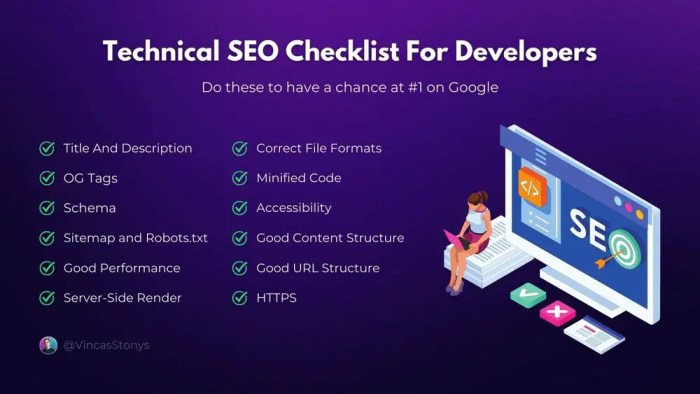Technical SEO Essentials for Developers: A Comprehensive Guide
Technical Essentials for Developers sets the stage for this enthralling narrative, offering readers a glimpse into a story that is rich in detail and brimming with originality. In this guide, we will delve into the crucial elements that developers need to master for optimal website performance and search engine visibility.
From website speed optimization to mobile-friendly design and schema markup, this guide will equip developers with the knowledge and tools necessary to enhance their strategies.
Overview of Technical Essentials for Developers
Technical is a critical aspect of website optimization that focuses on the backend elements of a site to improve its search engine visibility and ranking. Developers play a crucial role in implementing technical strategies to ensure a website performs well in search engine results pages (SERPs).
Key Technical Elements for Developers to Focus On
- Site Speed Optimization: Improving page loading times to enhance user experience and performance.
- Mobile Responsiveness: Ensuring the website is mobile-friendly and provides a seamless experience across devices.
- Structured Data Markup: Implementing schema markup to help search engines understand the content on the site better.
- XML Sitemap: Creating and submitting an XML sitemap to assist search engines in crawling and indexing website pages.
- Site Security (HTTPS): Securing the website with HTTPS to build trust with users and meet search engine requirements.
Understanding the Difference Between Technical and Traditional
While traditional focuses on content optimization, link building, and research, technical deals with the technical aspects of a website that impact its search engine visibility. It involves optimizing the website structure, performance, and code to enhance crawling, indexing, and ranking by search engines.
Website Speed Optimization
Improving website loading speed is crucial for user experience and rankings. A faster website not only keeps visitors engaged but also helps in ranking higher on search engine result pages.
Impact of Website Speed on Rankings
Website speed plays a significant role in determining search engine rankings. Search engines like Google consider page loading speed as one of the ranking factors. A slow website can negatively impact performance, leading to lower visibility and less traffic.
- Optimize images: Compress images without compromising quality to reduce file size. Use the correct image format (JPEG, PNG, SVG) based on the content.
- Minify CSS and JavaScript: Remove unnecessary spaces, comments, and characters from code to reduce file size. Combine multiple CSS and JavaScript files into one to reduce HTTP requests.
- Leverage browser caching: Set expiration dates for static resources like images, CSS, and JavaScript to reduce load time for returning visitors.
- Reduce server response time: Optimize server configurations, use a content delivery network (CDN), and minimize redirects to improve server response time.
Optimizing images, CSS, and JavaScript for speed is essential for improving website loading time and enhancing user experience.
Mobile-Friendly Design
Mobile responsiveness is crucial for as search engines prioritize websites that offer a seamless user experience across various devices, including mobile phones and tablets. With the increasing number of users accessing the internet through mobile devices, having a mobile-friendly website is essential to reach a wider audience and improve your search engine rankings.
Significance of Mobile Responsiveness
- Improved User Experience: A mobile-friendly design ensures that visitors can easily navigate your website, leading to longer session durations and lower bounce rates.
- Higher Search Engine Rankings: Search engines like Google prioritize mobile-friendly websites in their search results, which can positively impact your efforts.
- Increased Mobile Traffic: With more users browsing the internet on mobile devices, having a mobile-responsive website can attract a larger audience and drive more traffic to your site.
Tips for Creating a Mobile-Friendly Website
- Use a Responsive Design: Implement a responsive design that automatically adjusts the layout of your website based on the screen size of the device being used.
- Optimize Images and Videos: Compress images and videos to reduce loading times on mobile devices and improve overall performance.
- Mobile-Friendly Navigation: Simplify navigation menus and buttons to make it easy for mobile users to find the information they need.
- Test Across Devices: Ensure your website looks and functions properly on various mobile devices to provide a consistent user experience.
Impact of Responsive Design on
- -Friendly URLs: Responsive design helps maintain a consistent URL structure across different devices, making it easier for search engines to crawl and index your website.
- Reduced Bounce Rates: A mobile-friendly website with responsive design can lead to lower bounce rates, indicating to search engines that your content is relevant and engaging.
- Improved Page Speed: Responsive design can help improve page loading times on mobile devices, which is a crucial factor for both user experience and rankings.
URL Structure and Site Architecture
In the world of , having a clear URL structure and a well-thought-out site architecture is crucial for the success of your website. Let's dive into why these elements are so important and how they can impact your search engine rankings.
Importance of a Clear URL Structure for
Having a clear URL structure not only helps search engines understand the content of your pages but also provides a better user experience. When URLs are concise and descriptive, it becomes easier for both users and search engines to navigate your site and understand the hierarchy of your content.
- Include relevant s: Incorporating relevant s in your URLs can help improve your site's visibility in search results.
- Avoid dynamic parameters: URLs with dynamic parameters like session IDs or tracking codes can create duplicate content issues and make it harder for search engines to crawl and index your site.
- Use hyphens to separate words: When creating URLs, use hyphens to separate words instead of underscores or spaces. This makes URLs more readable and -friendly.
How Site Architecture Influences Search Engine Rankings
The way your website is structured can have a significant impact on how search engines perceive and rank your content
- Logical hierarchy: Organize your content in a logical hierarchy with clear categories and subcategories. This helps search engines understand the relationships between different pages on your site.
- Internal linking: Use internal links to connect related pages within your site. This not only helps users navigate your site but also distributes authority and helps search engines discover new content.
- Mobile-friendliness: Ensure your site is optimized for mobile devices, as mobile-friendliness is a crucial ranking factor for search engines like Google.
Schema Markup and Structured Data
Schema markup plays a crucial role in enhancing search results by providing search engines with specific information about the content on a website. This structured data helps search engines understand the context of the content, resulting in more relevant and rich snippets displayed in search results.
Types of Schema Markup Beneficial for
- Organization: Helps search engines identify the organization behind a website.
- Product: Provides detailed information about products, including price, availability, and reviews.
- Article: Allows search engines to display article-specific details like the author, date published, and article body.
- Local Business: Helps local businesses display relevant information such as address, phone number, and business hours.
Implementing Structured Data on a Website
- Use JSON-LD: Implementing schema markup using JSON-LD format is recommended as it is easy to read and understand by search engines.
- Validate Markup: Use Google's Structured Data Testing Tool to ensure that the structured data is implemented correctly and error-free.
- Update Regularly: Keep the structured data up to date with the latest information on your website to maintain its relevancy.
Canonical Tags and Duplicate Content

Canonical tags play a crucial role in by informing search engines about the preferred version of a web page when multiple versions exist. This helps prevent issues related to duplicate content and ensures that the right page gets indexed and ranked appropriately.
Significance of Canonical Tags in
Canonical tags are essential for resolving duplicate content problems that can negatively impact search engine rankings. By specifying the canonical URL, developers can consolidate link equity and prevent dilution of ranking signals across multiple versions of the same content. This helps search engines understand which version of the page to prioritize in search results, leading to improved visibility and traffic.
- Canonical tags help avoid penalties for duplicate content: Search engines penalize websites that have duplicate content by lowering their rankings. By implementing canonical tags, developers can consolidate duplicate pages and avoid these penalties.
- Improves crawl efficiency: By specifying the canonical URL, developers can streamline the crawling process for search engines, ensuring that the right page is crawled and indexed.
- Enhances user experience: Canonical tags help ensure that users land on the preferred version of a page, reducing confusion and providing a seamless browsing experience.
Impact of Duplicate Content on Search Rankings
Duplicate content can have a detrimental effect on search rankings by confusing search engines and diluting ranking signals. When multiple versions of the same content exist across different URLs, search engines may struggle to determine which page to rank, leading to lower visibility and traffic for the website.
- Ranking dilution: When search engines encounter duplicate content, they may spread ranking signals across multiple versions, reducing the overall visibility and authority of the website.
- Potential for penalties: Websites with significant amounts of duplicate content risk facing penalties from search engines, impacting their rankings and organic traffic.
Using Canonical Tags to Address Duplicate Content Issues
Developers can effectively use canonical tags to address duplicate content issues and improve the overall performance of a website. By implementing canonical tags correctly, developers can consolidate duplicate pages, guide search engines to the preferred version of the content, and enhance the site's visibility and ranking potential.
- Identify duplicate content: Conduct a thorough audit of the website to identify instances of duplicate content across different URLs.
- Implement canonical tags: Specify the canonical URL for each duplicate page to indicate the preferred version to search engines.
- Monitor and maintain: Regularly monitor the effectiveness of canonical tags and update them as needed to ensure that search engines are indexing the correct version of the content.
Ultimate Conclusion

As we conclude this exploration of Technical Essentials for Developers, it's evident that mastering these key elements is essential for achieving success in the ever-evolving digital landscape. By prioritizing technical best practices, developers can ensure their websites are optimized for maximum visibility and user experience.
FAQ Overview
How does website speed impact rankings?
Website speed is a crucial ranking factor in as search engines prioritize fast-loading sites for better user experience.
What is the significance of mobile responsiveness for ?
Mobile responsiveness is vital for as search engines prioritize mobile-friendly websites due to the increasing use of mobile devices for browsing.
Why is a clear URL structure important for ?
A clear URL structure helps search engines understand the content of a page, leading to better indexing and ranking.
How can developers optimize images for website speed?
Developers can optimize images by compressing them, using the correct file format, and specifying dimensions to reduce load times.




